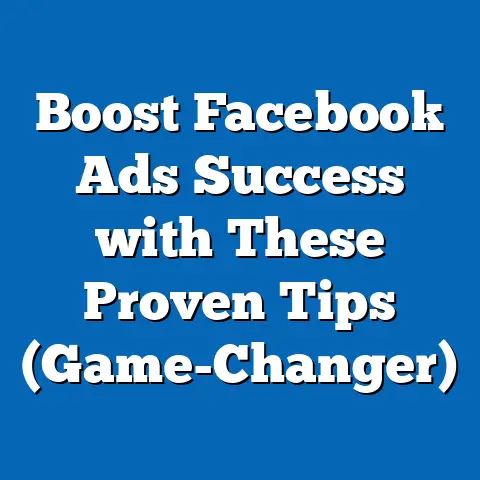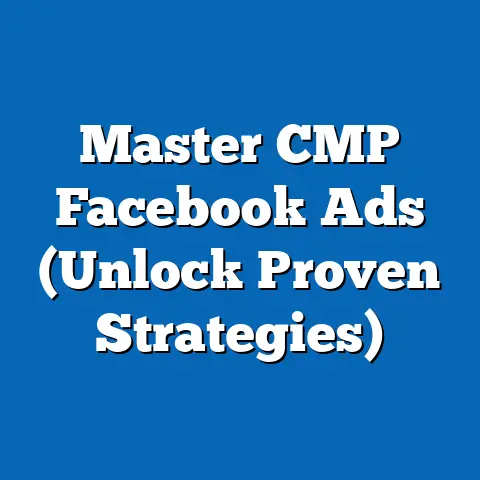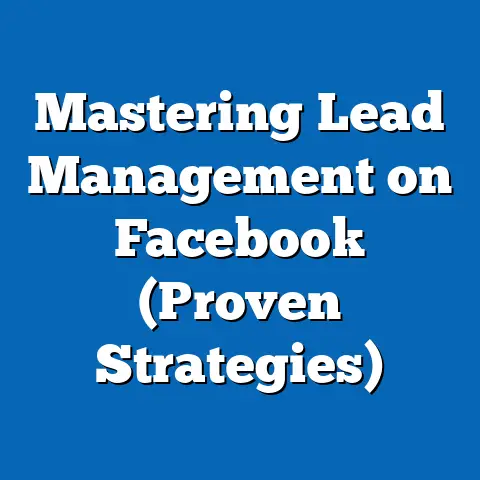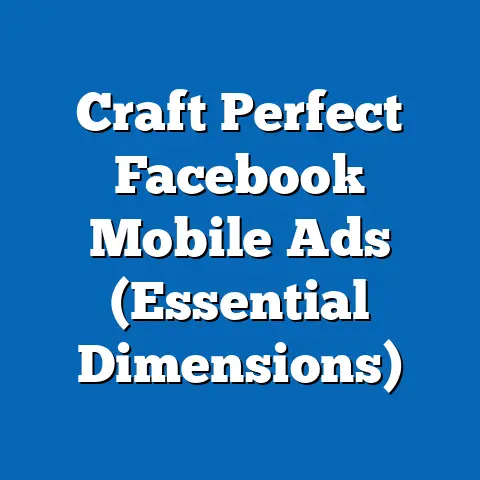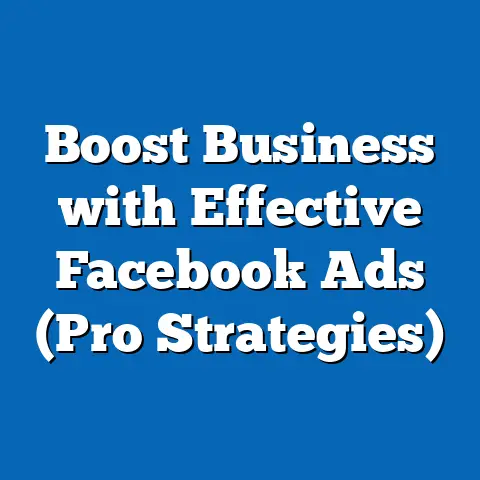Maximize Facebook Ad ROI Today (Proven Strategies)
What if you could transform a modest advertising budget into a revenue-generating powerhouse, reaching millions of potential customers with pinpoint accuracy? Imagine a small business owner, struggling to compete with larger brands, who invests $500 in a carefully crafted Facebook ad campaign and sees a return of $5,000 in sales within a month. This isn’t a far-fetched dream but a reality for many who have mastered the art and science of maximizing return on investment (ROI) through Facebook advertising.
In today’s hyper-connected digital landscape, Facebook remains a juggernaut for advertisers, boasting over 2.9 billion monthly active users as of 2023 (Statista, 2023). With its unparalleled ability to target specific demographics, interests, and behaviors, the platform offers businesses of all sizes an opportunity to achieve exceptional ROI—if they know how to navigate its complexities.
Defining Characteristics of Successful Facebook Ad Campaigns
At the heart of any high-ROI Facebook ad campaign lies a deep understanding of its core components: targeting, creative content, and data-driven optimization. Unlike traditional advertising, where broad reach often trumps precision, Facebook’s strength is its ability to deliver ads to highly specific audiences based on demographics, interests, and online behavior. A 2022 study by Hootsuite found that 78% of marketers cite precise targeting as the primary driver of their Facebook ad success.
Successful campaigns also prioritize compelling creative elements—think eye-catching visuals, persuasive copy, and clear calls-to-action (CTAs). For instance, video ads on Facebook have been shown to generate 12 times more shares than text and image ads combined (WordStream, 2022), underscoring the importance of dynamic content.
Finally, continuous optimization through analytics is non-negotiable. High-ROI campaigns leverage tools like Facebook Ads Manager to track metrics such as click-through rates (CTR), cost-per-click (CPC), and conversion rates, adjusting strategies in real-time to maximize performance. This iterative approach separates the amateurs from the experts in the digital ad space.
Historical Context: The Evolution of Digital Advertising and Facebook’s Rise
To fully grasp the significance of Facebook advertising today, it’s essential to understand the broader historical context of digital marketing. The late 1990s marked the dawn of online advertising with the introduction of banner ads, which were rudimentary and often intrusive. By the early 2000s, Google’s AdWords platform revolutionized the industry with pay-per-click (PPC) advertising, emphasizing relevance and user intent over sheer volume.
Facebook entered the scene in 2007 with its first ad platform, initially offering simple sidebar ads to a relatively small user base. However, as the platform’s user numbers skyrocketed—reaching 1 billion by 2012—so did its advertising capabilities. The introduction of the News Feed ad format in 2012 allowed brands to integrate seamlessly into users’ social experiences, while the launch of the Facebook Pixel in 2015 enabled precise tracking of user actions, from website visits to purchases.
This evolution reflects broader societal shifts toward digital connectivity and data-driven decision-making. The rise of smartphones, with 6.6 billion users worldwide by 2023 (Statista, 2023), further amplified Facebook’s reach, making mobile-first ad strategies a cornerstone of modern campaigns. Today, Facebook advertising isn’t just a tool; it’s a cultural and economic force, shaping how businesses connect with consumers in an increasingly online world.
Societal Implications: The Double-Edged Sword of Facebook Advertising
The societal impact of Facebook advertising extends far beyond business outcomes, influencing consumer behavior, privacy norms, and even political landscapes. On one hand, the platform democratizes marketing by leveling the playing field for small businesses, allowing them to compete with industry giants through cost-effective, targeted campaigns. A 2021 survey by the U.S. Small Business Administration found that 65% of small business owners credit social media advertising, particularly on Facebook, with helping them survive economic challenges like the COVID-19 pandemic.
On the other hand, the precision of Facebook’s targeting raises ethical concerns about data privacy and manipulation. High-profile scandals, such as the 2018 Cambridge Analytica incident, exposed how personal data could be exploited for political advertising, sparking global debates over user consent and platform accountability. Moreover, the “echo chamber” effect—where algorithms reinforce users’ existing beliefs through targeted content—has been linked to increased polarization in society (Pew Research Center, 2020).
Economically, Facebook advertising drives significant job creation and innovation in the digital marketing sector, with the global social media ad market projected to reach $207 billion by 2025 (eMarketer, 2023). Yet, it also contributes to “ad fatigue” among consumers, with 74% of users reporting frustration with irrelevant or repetitive ads (HubSpot, 2022). Balancing effectiveness with ethical responsibility remains a critical challenge for advertisers aiming to maximize ROI without alienating their audience.
Proven Strategies for Maximizing Facebook Ad ROI
To navigate this complex landscape, businesses must adopt proven, data-backed strategies tailored to Facebook’s unique ecosystem. Below, we break down key approaches across targeting, content creation, budget management, and performance analysis, providing actionable insights for advertisers at all levels.
1. Precision Targeting: Know Your Audience Inside Out
The foundation of any high-ROI campaign is a deep understanding of the target audience. Facebook’s robust targeting options allow advertisers to segment users by age, gender, location, interests, and even life events like engagements or new parenthood. For instance, a wedding planner could target users who recently got engaged, while a fitness brand might focus on individuals interested in health and wellness.
Lookalike Audiences are another powerful tool, enabling businesses to reach users similar to their existing customers based on data from the Facebook Pixel or email lists. According to a 2022 case study by Shopify, e-commerce brands using Lookalike Audiences saw a 30% increase in conversion rates compared to broader targeting methods.
However, nuance is key. Over-targeting can shrink your audience pool and drive up costs, while under-targeting risks irrelevant impressions. Striking the right balance requires ongoing testing and refinement, using A/B testing to compare different audience segments and identify the most responsive groups.
2. Compelling Creative: Stand Out in a Crowded Feed
With users scrolling through hundreds of posts daily, your ad must capture attention within seconds. High-performing Facebook ads often feature bold visuals, concise messaging, and a clear value proposition. Video content, in particular, reigns supreme—ads with video have an average CTR of 1.84%, compared to 0.9% for static images (Databox, 2023).
Storytelling is another effective tactic. Ads that evoke emotion or tell a relatable story tend to resonate more deeply with audiences. For example, a pet food brand might share a heartwarming video of a rescued dog thriving on their product, paired with a CTA like “Give Your Pet the Best—Shop Now.”
Importantly, creative should align with the platform’s mobile-first nature. Over 98% of Facebook users access the platform via mobile devices (Statista, 2023), so ads must be optimized for smaller screens with vertical formats like Stories or Reels. Testing multiple creative variations—different headlines, images, or CTAs—can also reveal what drives the highest engagement.
3. Budget Optimization: Spend Smart, Not Big
Maximizing ROI doesn’t mean spending more; it means spending smarter. Facebook’s Campaign Budget Optimization (CBO) tool automatically distributes your budget across ad sets to prioritize the best-performing ones, reducing wasted spend. A 2021 study by Social Media Examiner found that advertisers using CBO reported a 20% lower cost-per-acquisition (CPA) on average.
Start with a modest budget to test different strategies, then scale up once you identify winning combinations. Bidding strategies also matter—opt for cost-per-action (CPA) bidding if your goal is conversions, or cost-per-thousand-impressions (CPM) if brand awareness is the focus. Additionally, avoid “boosting” posts indiscriminately, as this often yields lower ROI compared to structured campaigns built in Ads Manager.
Timing plays a role too. Analyze when your audience is most active using Facebook Insights, and schedule ads for peak engagement hours. For instance, B2B ads might perform better during weekday mornings, while consumer products often see spikes on weekends.
4. Leverage Advanced Ad Formats and Placements
Facebook offers a variety of ad formats, each suited to different objectives. Carousel ads, which showcase multiple images or products in a swipeable format, are ideal for e-commerce, boasting a 72% higher CTR than single-image ads (AdEspresso, 2022). Collection ads, meanwhile, allow users to browse a mini-catalog directly within the app, streamlining the path to purchase.
Dynamic ads automatically tailor content to individual users based on their browsing history, making them a go-to for retargeting. A clothing retailer, for example, could show a user the exact pair of shoes they viewed on their website, increasing the likelihood of conversion. According to Facebook, dynamic ads deliver 3 times the return on ad spend compared to standard formats (Meta, 2023).
Placement is equally critical. While News Feed ads remain the most popular, don’t overlook Instagram (owned by Meta), Messenger, or the Audience Network for additional reach. Automatic Placements, a feature that lets Facebook decide where ads appear, often yields better results for beginners, though advanced users may prefer manual control to optimize for specific platforms.
5. Data-Driven Optimization: Measure, Analyze, Adapt
Retargeting is another powerful way to boost ROI. By targeting users who’ve interacted with your brand (e.g., visited your website or abandoned a cart), you can recapture lost opportunities. Studies show retargeted ads have a 10 times higher CTR than display ads targeting new users (Criteo, 2022).
Finally, don’t ignore qualitative feedback. Monitor comments and messages on your ads to gauge sentiment and address concerns in real-time. This not only improves campaign performance but also builds trust with your audience, fostering long-term loyalty.
Comparing Generational Responses to Facebook Ads
Generational differences play a significant role in how audiences engage with Facebook ads, and understanding these nuances can sharpen targeting strategies. Baby Boomers (born 1946–1964), for instance, value trust and reliability, often responding well to ads with clear benefits and testimonials. A 2021 AARP study found that 60% of Boomers on Facebook are influenced by ads featuring real customer stories.
Generation X (born 1965–1980) tends to prioritize value for money, gravitating toward promotions and discounts. They’re also more likely to research products before purchasing, making retargeting campaigns particularly effective for this cohort (Nielsen, 2022).
Millennials (born 1981–1996) and Gen Z (born 1997–2012), meanwhile, dominate Facebook’s user base and are drawn to authenticity and social impact. Ads that highlight a brand’s values—such as sustainability or diversity—resonate strongly, with 70% of Millennials saying they’ve purchased from brands aligned with their beliefs (Deloitte, 2022). Gen Z, in particular, favors interactive formats like Stories and Reels, reflecting their preference for quick, engaging content.
However, it’s critical to avoid overgeneralizations. Not all Millennials are tech-savvy trendsetters, nor are all Boomers resistant to digital innovation. Within each generation, factors like income, location, and personal interests create diverse responses to advertising, necessitating granular targeting over broad assumptions.
Technological, Economic, Social, and Cultural Factors Influencing Ad Success
The effectiveness of Facebook ads is shaped by a web of interconnected factors beyond the platform itself. Technologically, the rise of artificial intelligence (AI) and machine learning has transformed ad delivery, with Facebook’s algorithms predicting user behavior with uncanny accuracy. However, Apple’s 2021 iOS 14 update, which limited data tracking, forced advertisers to adapt to reduced targeting precision, emphasizing the importance of first-party data like email lists (Forbes, 2022).
Economically, fluctuations in disposable income and consumer confidence impact ad performance. During recessions, for instance, cost-conscious messaging outperforms luxury-focused campaigns, as seen during the 2020 pandemic when discount-driven ads saw a 25% higher conversion rate (McKinsey, 2021).
Socially, the growing demand for transparency and ethical practices influences how brands craft their messaging. Consumers increasingly expect companies to take stands on issues like climate change or social justice, and ads reflecting these values can build deeper connections. Culturally, localization matters—ads tailored to regional languages, holidays, or traditions often outperform generic content, especially in diverse markets like India or Brazil (Meta, 2023).
Implications for Businesses, Society, and the Workplace
For businesses, mastering Facebook ad ROI isn’t just about profits; it’s about survival in a digital-first economy. Small and medium enterprises (SMEs), in particular, benefit from the platform’s affordability and scalability, with 90% reporting that social media ads are critical to their growth (Hootsuite, 2022). Larger corporations, meanwhile, use Facebook to maintain brand relevance and test new markets with minimal risk.
In the workplace, the rise of digital advertising has spurred demand for specialized roles like social media managers, data analysts, and content creators. The U.S. Bureau of Labor Statistics projects a 10% growth in marketing-related jobs by 2030, driven largely by platforms like Facebook. However, this also raises questions about job security for traditional marketers who must upskill to remain competitive.
Societally, the omnipresence of targeted ads shapes consumer culture, often blurring the line between want and need. While this drives economic activity, it also fuels overconsumption and debt, particularly among younger generations susceptible to impulse buying (Pew Research Center, 2021). Addressing these challenges requires a collective effort from platforms, advertisers, and policymakers to promote responsible marketing practices.
Conclusion: Looking Ahead with Cautious Optimism
Maximizing Facebook ad ROI today demands a blend of creativity, analytical rigor, and ethical awareness. As we’ve explored, proven strategies—precise targeting, compelling creative, smart budgeting, advanced formats, and data-driven optimization—can transform modest investments into significant returns. Yet, the landscape is ever-shifting, influenced by technological innovations, economic trends, and societal expectations.
Looking forward, the future of Facebook advertising holds both promise and uncertainty. Emerging technologies like augmented reality (AR) ads and the metaverse could redefine engagement, while regulatory changes around data privacy may reshape targeting capabilities. Businesses must remain agile, prioritizing adaptability over complacency, to stay ahead of the curve.
Ultimately, the power of Facebook ads lies not just in their ability to drive sales but in their potential to connect brands with people in meaningful ways. By balancing profit with purpose, advertisers can harness this tool to build not only successful campaigns but also a more responsible digital ecosystem for generations to come.


